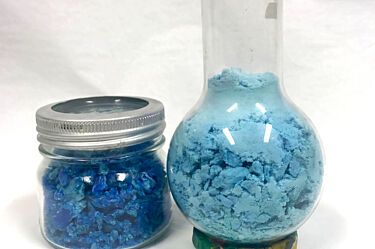
Object of the month: Bluestone (1960s)
At the museum there are currently two exhibitions surrounding the themes of water, culture and fishing: the art exhibition "Waterworks" by Svein Flygari Johansen, and "Na, maid dàl? Sami cultural heritage coming back home."
Therefore I have chosen something from our collection associated with sea fishing: two glass jars containing many small, blue stones. At first glance they may look like something bought in a interior decoration boutique. However, this is anything but decorative. What you see here is a container with toxic copper sulphate, popularly called bluestone.
But what have these got do with fishing?
Bluestone had a number of uses. It was dissolved in water and used to impregnate fishing nets and ships ropes so that the fibres wouldn't rot and the nets would be thoroughly cleaned. In addition, the net would take on a blue colour which was suited to deep-sea fishing. It was a laborious process. While the net was drying out for three or four days after being used, the bluestone was placed in a bark bath and dissolved. Preferably fresh water was used for this, but salt water could also be used. The net was lowered into the bath and kept in the solution for two or three days before it was taken out and dried, ready to be used again. The drying process could not be done in sunlight as the net would be scorched. A net could be used for about two weeks before it needed bluestone treatment again.
There are many stories connected with the use of bluestone. Fishermen have told about the danger of it burning the skin if you got it directly on you. Others told that a cigarette tasted sweet if you didn't wash your hands thoroughly after handling impregnated nets and ropes. Some remember how as children they wrote their names in lubricating grease on knife blades and put the knives into the bluestone solution. After a day or two their names would be engraved into the knife blade.
After synthetic nets and ropes replaced the organic ones, there were no longer necessary to impregnate nets with solutions of bluestone.
Anne Klippenvåg Pettersen - curator